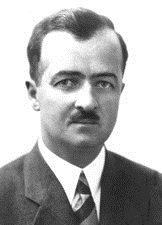C. Douglass Buck
Clayton Douglass Buck ( born March 21, 1890, New Castle, Delaware; † January 27, 1965 ) was an American politician and 1929-1937 Governor of the State of Delaware. Between 1943 and 1949 he represented his state in the U.S. Senate.
Early years and career
Douglass Buck, as he was called, was the great-grandnephew of John Middleton Clayton, who represented 1829-1836 the State of Delaware in the U.S. Senate. Buck attended the Friends School and the University of Pennsylvania, where he studied the engineering. In 1916 he became head of the Roads Authority ( Highway Department ) in New York State. After that he took part as a simple soldier in the First World War. Between 1922 and 1929 he led the Highways Agency in Delaware.
Governor of Delaware
Douglass Buck was a member of the Republican Party. Until 1928, he was politically hardly have appeared. In this year he was but elected as a candidate of his party with 61 % of the votes against Charles M. Wharton, the candidate of the Democratic Party for governor of his state. He took up his new post on 15 January 1929. In 1932 he was confirmed as the first governor of Delaware under the applicable 1897 state constitution by voters in this office. This time he received 54 % of the vote, while his Democratic rival candidate L. Landreth Layton came to 45%. This election was remarkable, because at that election in the United States almost everywhere victorious Democrats. The highlight of this development was the election of Franklin D. Roosevelt as the new President.
Almost the entire eight -year term of Douglass Buck was overshadowed by the global economic crisis, which has left its traces in Delaware. As a countermeasure, the governor called in November 1932, the legislative one at a special meeting. There is a $ two million comprehensive aid program was adopted. Later, other programs and the New Deal the federal government, which then the crisis could be gradually overcome in the course of the 1930s followed. Until then, many citizens and public servants had to accept pay cuts. Many others were unemployed. Was also in 1932 in Delaware the 21st Amendment to the Constitution, the repeal of Prohibition ratified. During his time, he was governor from 1930 to 1937 a member of the Republican National Committee. After the expiration of his term Douglass Buck resigned from his post on 19 January 1937.
Buck in the U.S. Senate
In 1942 he was elected with 54% of the vote against the Democrats Ennals E. Berl as a Class 2 senator to succeed James H. Hughes. He represented his country between January 1943 and January 3, 1949 U.S. Congress 3. He was chairman of the committee which dealt with the District of Columbia. In 1948 he stood for re-election, but was defeated with 48% against 51 % of the votes the Democrats Joseph Allen Frear.
Further CV
Between 1953 and 1957, Buck was a tax officer of the State of Delaware. After he retired from politics, but remained active business. He was now also involved in banking. He died in January 1965 and was buried in New Castle. With his wife Alice du Pont, daughter of U.S. Senator Thomas Coleman du Pont, Douglass Buck had two children.










